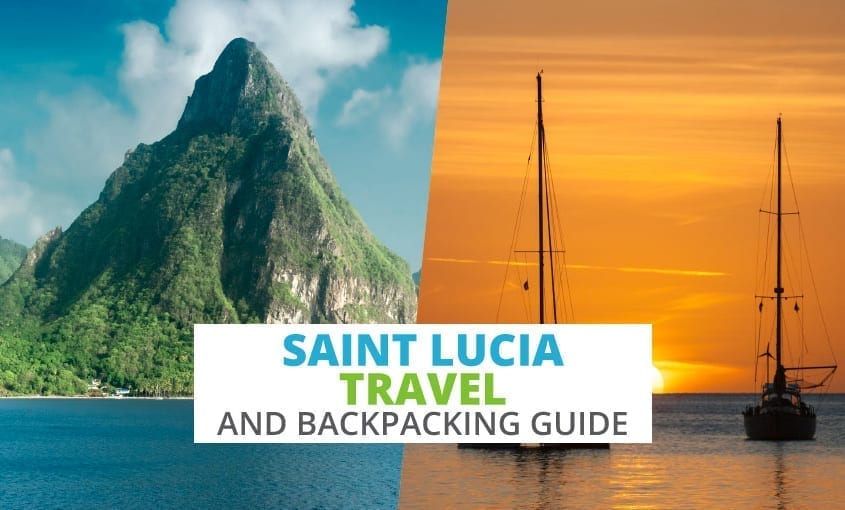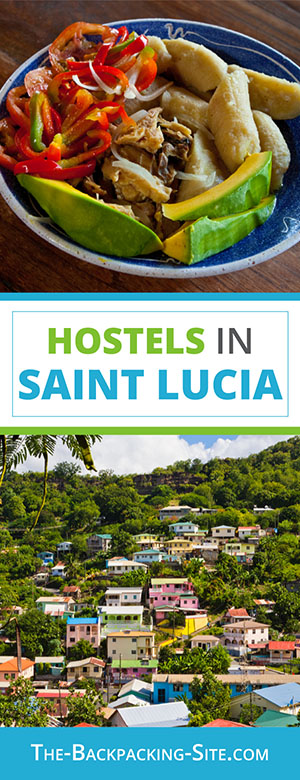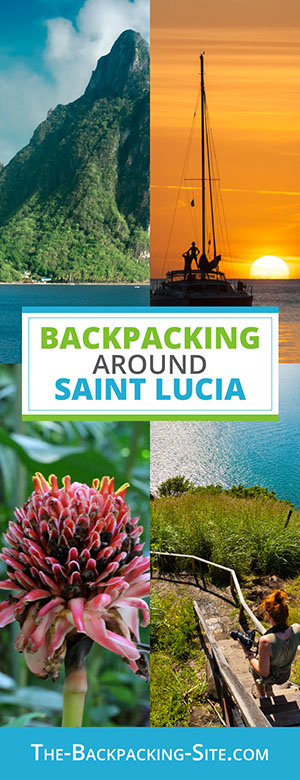
Backpacking Saint Lucia
Looking for important travel information while backpacking in Saint Lucia? Here you will find information on working in Saint Lucia, entry visas, Saint Lucia hostels, and much more.
Table of Contents
- Facts About Saint Lucia
- Entry Visa Requirements for Saint Lucia
- Work Permits and Backpacker Jobs in Saint Lucia
- Saint Lucia Hostels
Facts About Saint Lucia
Framed by the Eastern Caribbean Sea and the Atlantic Ocean, Saint Lucia is an island of rare beauty steeped in fascinating history. Though possessing a population of fewer than 170,000 people (based on a 2005 census) and measuring only 239 square miles, this Windward Island of the Lesser Antilles has assimilated the numerous outside influences of its eventful past into a distinct national culture.
It is now thought almost certain that Christopher Columbus never actually alighted at Saint Lucia in 1499. However, colonial expansion would soon arrive at her shores in the form of European nations seeking trading outposts in the Caribbean. Facing resistance from the indigenous Carib rulers (who had triumphed in their struggle with the Arawaks centuries earlier), the European powers nonetheless continued to seek a strong foothold on the island.
This fierce competition ushered in a period of around 150 years (beginning in the mid-17th Century) during which Saint Lucia became a battleground for French and British armies. Possession of the island switched on numerous occasions before Saint Lucia was eventually ceded to the British in 1815.
Saint Lucia remained a British possession throughout both world wars, and became an outpost for US troops in the 1940s. Though Queen Elizabeth II remains Head of State, the island gained full independence on February 22nd 1979, a date recognised during yearly celebrations.
Though most islanders can also speak Kweyole (similar to French), the official language is English.
Climate in Saint Lucia
Saint Lucia’s dry season runs from December through to May, during which time average temperatures range from around 21 to 29°C. The rainy season, running from June until November, boasts higher temperatures in addition to infrequent but very heavy downpours. Travelling during the latter season can reduce costs by upwards of fifty percent. Temperatures and humidity in Saint Lucia are often countered by North-eastern trade winds, making the heat somewhat more bearable for those unused to the Caribbean.
Things to do in Saint Lucia
Belying its small size, Saint Lucia offers a number of attractions sure to please a whole range of visitors. Most resorts are situated along the western coastline of the island, leading up to the capital, Castries, in the North West.
When deciding the best things to do in Saint Lucia, there is an abundance of options. Here are the top bucket-list items when backpacking Saint Lucia.
Castries
Almost entirely rebuilt several times in the past (the last occasion following a huge fire in 1948), Castries acts as the hub of Saint Lucia. It houses the government, the island post-office, and a buzzing (though not yet over-developed) tourist industry. Visitors are drawn to the Cathedral of the Immaculate Conception, situated close to Derek Walcott Square. Walcott’s acceptance of the Nobel Prize for literature in 1992 has helped Saint Lucia to achieve its status as the world’s most fertile breeding ground for Nobel Prize winners per head of population. Morne Fortune represents a highly interesting reminder of Castries’ past need for strong fortification.
Numerous craft markets, particularly in Castries, offer unique batik and silkscreen designs and further shopping desires can be indulged at Pointe Seraphine which boasts over 30 duty-free shops.
Explore the Natural Beauty
Saint Lucia can truly lay claim to some of the most beautiful natural scenery in the region. The iconic Piton Mountains which loom 2,000 feet over the south-western port of Soufriere, are an absolute must, and contain the world’s only drive-in volcano!
Marigot Bay’s natural harbour has an interesting past as a common hideout for pirate vessels. The island’s central mountain range is adorned with lush rainforests nurturing rare species, fabulous wild orchids and giant ferns. These can be explored during rainforest walks, or even by car (should you be brave enough to tackle the hairpin bends).
The Botanical Gardens are an equally enjoyable way to experience the unspoilt Caribbean habitat of the island. Be sure to catch a glimpse of the Jacquot, Saint Lucia’s national bird.
Sample the Local Cuisine
The local cuisine is a delicious combination of Creole, French and West Indian influences. Definitely ones to try are the local lobster (or langoste), Saint-Lucian brewed Piton Beer, and famous Caribbean rum. It can all be sampled to a soundtrack of traditional calypso, zouk and reggae, and in smaller fishing villages, to the relaxing sound of the ocean.
Gos Islet, a relatively new town and host to matches during the 2007 Cricket World Cup, holds a street party every Friday night for those seeking to show off their dance steps. Revellers may wish to practice their Quadrille before Saint Lucia’s mid-July carnival, or attend the May-time annual Jazz Festival. Two of Saint Lucia’s most enjoyable nightclubs are Indies and The Late Time. Alternatively visit the small sleepy port of Soufriere, the birthplace of Napoleon’s Empress Josephine de Beauhamais, for a slice of the relaxed Caribbean.
Visit Vieux Fort
An outing to Vieux Fort in the South is highly recommended, Saint Lucia’s second largest settlement with a gorgeous Old Town area. The resort also hosts a surprisingly large fish market on Fridays and Saturdays, selling both familiar treats, along with a few types you probably haven’t eaten before.
Relax on the World-Class Beaches
No visit to St Lucia would be complete without going to some of the incredible beaches that characterize the island, blessed as they are with white sand and clear blue sea. Malabor, and the Choc and La Toc Beaches are just a few of the large number on offer. Such delightful coastlines have contributed to Saint Lucia’s status as a honeymoon and wedding hotspot (nearly 10 marriages a day in 2006), but the beaches offer an equally big opportunity for less romantic exploits, such as water-sports (Anse de Feble is great for windsurfing) or snorkelling and scuba diving. The island also has three great golf courses.
Boooking Activities in Saint Lucia
Since popular places in Saint Lucia can get crowded during tourist season, it is wise to reserve tickets and activities ahead of time. GetYourGuide sells entrance tickets to museums and landmarks at face value so you can avoid the lines and save that precious time for more exploring.
Viator is another popular travel website that helps you book things to do in Saint Lucia. They work directly with local tour operators in Saint Lucia, so you won’t have to scour the internet or roam around town trying to find the best deal.
How to Find Cheap Flights to Saint Lucia
In order to find the best flights to Saint Lucia we recommend using a few well-known flight comparison search engines. These websites offer powerful search options, like entering flexible dates and airports in order to find the cheapest flight to Saint Lucia.
Our go-to flight search engine is Skyscanner, which we love for its extremely flexible search options. Our favourite way to get travel inspiration is their “Everywhere” feature. Simply enter “Everywhere” as a destination, and it will then list all available flights from your departure city in order of price. This also works when entering the entire country of Saint Lucia as your destination. Skyscanner will search all possible airports in the country in order to find the cheapest option.
Kiwi is another new favourite flight search engine among savvy travelers. Kiwi works by combining flights from different carriers in order to get the best deal. Also, if there is a better ground or ferry option for the route you’re searching, Kiwi will include that in the search results. On average, we have found the cheapest flights to Saint Lucia with them compared to the other websites out there.
Saint Lucia is served by two airports, the George FL Charles (or Virgie Airport) and Hewanorra International Airport, near Vieux Fort. Served by Caribbean Start and LIAT amongst others, the airport is about a one and a half hour drive from the capital, along the east coast road.
How to Travel Around Saint Lucia on a Budget
When travelling around Saint Lucia, you will have the option of rental car, bus, taxis, and ferries.
Car hire is readily available in advance or on arrival, roads are generally of a high standard and St Lucians drive on the left-hand side. Though there is no rail service on the island, there are good bus-links including those to and from the airport. By way of an example, the Castries to Gros Islet bus runs every 30 minutes and these vehicles can often be flagged down. Taxis are also cheap with no tipping necessary, but be sure to arrange a fixed rate upon getting in the car. Numerous ferries also link Castries to Fort-de-France and Soufriere.
If you decide you want to rent a car in Saint Lucia, you can use DiscoverCars to compare offers from the major car rental agencies in the region.
Entry visa requirements for Saint Lucia
A visa is only required for UK citizens if you’re going to be staying for more than six weeks. You will also need a valid passport (in fact, as long as you have another form of photo identity, an expired passport is sufficient).
Visa requirements for Saint Lucia can vary widely depending on your country of origin and can change over time. To avoid any unpleasant surprises, be sure to check the latest visa requirements while you’re still planning your trip.
Health and safety in Saint Lucia
As with travel to all other countries abroad, it is vital that you get travel insurance before you leave for Saint Lucia. Even for short trips, our go-to travel insurance provider is World Nomads, which is also recommended by Lonely Planet, HostelWorld, and other major travel companies.
- Local healthcare is extremely expensive, so visitors should take out full health insurance for the duration of their stay.
- It is advised to drink bottled water in Saint Lucia.
- Hepatitis A and Tetanus jabs are required. Diphtheria, Typhoid, TB, and Hepatitis B can sometimes be required, and this should be checked with your GP.
- Beachwear should not be worn in towns, and any camouflage clothing is illegal.
- There is a rising risk of violent crime in Saint Lucia, and the Foreign Office recommends that vigilance be exercised with regard to this.
Foreigner work permits and backpacker jobs in Saint Lucia
Visitors thinking about taking on paid employment while in St. Lucia need to organise a work permit. The process, which is carried out by the St. Lucia UK High Commission, is relatively simple. However, it is worth remembering that you will need someone from St. Lucia to sign one of the forms for you. It is also essential to know when the job will begin, as applications must be submitted two months before starting work. There is also a small fee to pay.
Some people even decide to uproot and move to St Lucia. If this is something you are considering, you can look into Citizenship by Investment St Lucia programs. There are specialist agencies that can help you every step of the way if this is something that you are interested in.
Volunteering in Saint Lucia
Volunteer travel is a great way to explore Saint Lucia on a budget while also giving back. Typically, you’ll work on the project a set number of hours per week in exchange for free accommodation, and sometimes other perks such as free food, free bike rentals, and more.
If volunteer work in Saint Lucia sounds like something you want to do, it’s best to do it via a reputable agency. An agency will help screen volunteer programs and hosts in Saint Lucia to make sure you have support every step of the way.
Volunteer work in Saint Lucia can be organized through the WorldPackers agency, and you can use promo code BACKPACKING10 to save $10 on your membership. WorldPackers can connect you with volunteering opportunities in Saint Lucia with NGOs, hostels and homestays, agricultural or wildlife experiences, and more.
Saint Lucia Hostels and Budget Accommodation

As previously mentioned, Saint Lucia is something of a favourite for both newlyweds and couples in search of a romantic break. Although this is true, the island is similarly recommended for families and parties looking to enjoy both active vacations and more cultural excursions. Hence, Saint Lucian hotels require some research before booking as they look to target specific groups of people.
A reasonably wide variety of prices are in evidence, yet Saint Lucian hotels have good reputations for service and comfort, meaning that many of those on offer represent very good value. The Landera was recently voted the best hotel in the world by Conde Nast, but for those on a tighter budget (which judging by the Landera’s prices should be plenty), options remain plentiful. Hotels such as the Villa Beach cottages at Castries meet all but the most extravagant requirements.
Though many choose to stay self-catering or half-board, all-inclusive deals are becoming increasingly popular for holidays in Saint Lucia. The island has a small number of hostels, of which the Bibs International Backpackers hostel comes with a seal of approval. Camping is also available at the Anse la Liberte.
We have had good experiences finding hostels in Saint Lucia on HostelWorld. They have the largest inventory of hostels worldwide, and with over 10 million reviews and ratings from other travellers, you know exactly what to expect.
Another good way to find accommodation in Saint Lucia is by checking booking.com. You’ll find hotels, homestays, hostels, and other unique accommodations. They have the most reviews and advanced filtering of any accommodation-booking site, so you’ll be sure to find a great place in your budget. Many of the places on booking.com also offer free cancellation, which takes the pressure off the planning phase of your trip to Saint Lucia.
If you are backpacking with another travel companion, we highly recommend booking a rental via VRBO. With a vacation rental in Saint Lucia, you’ll have more space, your own kitchen, and you’ll get a better feel for how the locals live. Plus, the cost of a vacation rental can be split among your group, oftentimes making it cheaper than doing individual hotel rooms.
If you’re looking to save even more money while backpacking in Saint Lucia, there are plenty of creative ways to get free accommodation in exchange for work. For example, one of our favorite ways to stay in amazing locations for free is by signing up as a petsitter with Trusted Housesitters. The site connects responsible animal lovers with petsitting opportunities in Saint Lucia and all over the world. It’s a win-win for both sides – travellers can stay in amazing locations for free, and homeowners can rest easy knowing that someone is watching over their place.
And lastly, CouchSurfing is a great community that connects travellers with local hosts in Saint Lucia. You can stay for free with verified hosts, who will usually take some time to show you around the local spots.
Helpful links for backpacking in Saint Lucia
- DiscoverCars – The world’s leading rental car search engine to rent a car in Saint Lucia
- Kiwi and Skyscanner – Flight comparison search engines to find the cheapest flights to Saint Lucia and within the country
- GetYourGuide and Viator – a collection of local tours and activities in Saint Lucia. Also offers Skip the Line tickets for crowded attractions
- HostelWorld – #1 hostel search website to find accommodation while backpacking Saint Lucia. Thousands of hostels and millions of reviews from fellow travellers
- Booking.com – commonly used booking site for accommodation in Saint Lucia. Find hostels, hotels, and other unique accommodations in Saint Lucia with advanced filtering and millions of reviews
- World Nomads Travel Insurance – Comprehensive travel insurance for long and short trips when backpacking Saint Lucia
There you have it, the ultimate Saint Lucia backpacking guide. We hope you have found all the information you need for backpacking around Saint Lucia.
Next up:
- Backpacking Barbados
- Backpacking Jamaica
- Backpacking Saint Kitts and Nevis
- Backpacking Trinidad and Tobago
Liked this article? Share it with others who might be after the same information!


Leave a Reply
Want to join the discussion?Feel free to contribute!